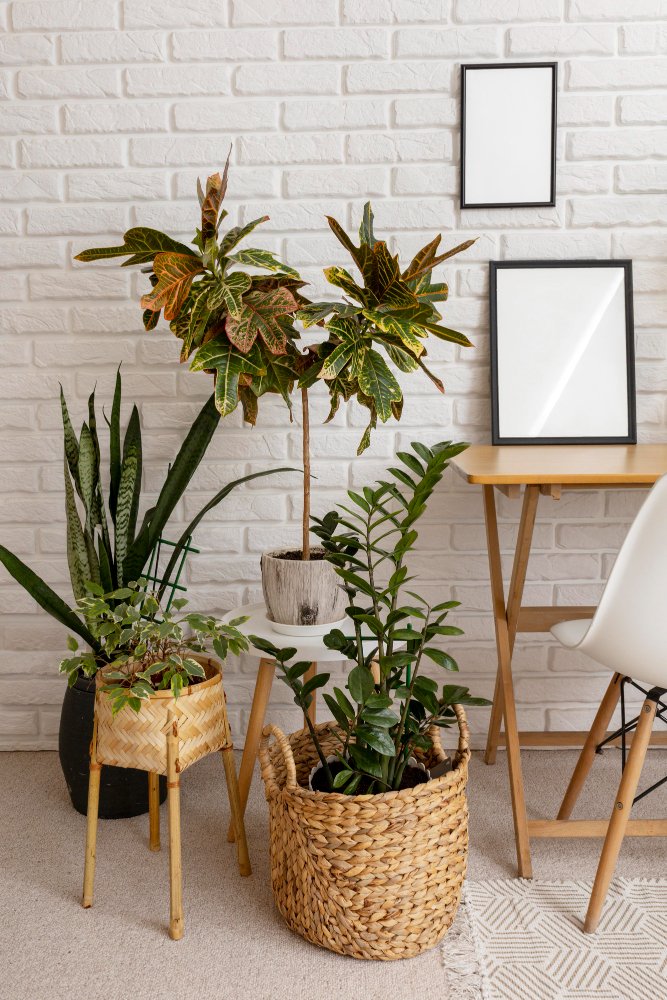In modern workplaces, the design of an office can significantly affect employee well-being and productivity. While ergonomic furniture and bright lighting are commonly emphasized, office indoor plants are often overlooked—even though they provide substantial benefits. Adding greenery to your workspace not only enhances aesthetics but can also reduce stress, improve air quality, and boost overall productivity.
In this guide, we’ll explore the best indoor plants for offices, provide practical care tips, and explain why having plants in your workspace can be a game-changer.
Why Indoor Plants Are Important for Offices
Indoor plants offer several advantages that directly impact work performance and satisfaction:
- Stress reduction: Greenery creates a calming environment that reduces stress levels.
- Improved air quality: Plants can filter out pollutants like formaldehyde and benzene.
- Increased productivity: Studies suggest employees are more focused and creative in plant-filled environments.
- Noise reduction: Certain plants help absorb background noise, creating a quieter office.
- Enhanced aesthetics: Plants make office spaces more inviting and vibrant.
With these benefits, it’s clear that office indoor plants are more than decorative—they are an investment in employee health and efficiency.
Traits of the Best Office Indoor Plants
When selecting indoor plants for office spaces, consider plants that have the following traits:
- Low-maintenance: Can survive with minimal care.
- Tolerant to low light: Many offices have limited natural light.
- Compact or flexible size: Fits desktops, shelves, or corners without cluttering the space.
- Air-purifying qualities: Improves indoor air and contributes to a healthier environment.
Choosing plants with these traits ensures that your office greenery thrives without adding extra work for employees or maintenance staff.
1. Snake Plant (Sansevieria trifasciata)
Snake plants are popular for their striking upright leaves and resilience.
Care Tips:
- Light: Thrives in low to bright indirect light.
- Water: Every 2–3 weeks; allow soil to dry between waterings.
- Maintenance: Minimal; wipe leaves occasionally.
Why it’s ideal for offices: Snake plants are almost indestructible, require minimal watering, and can improve air quality, making them perfect for busy office environments.
2. ZZ Plant (Zamioculcas zamiifolia)
ZZ plants are glossy-leafed, drought-tolerant plants that can survive in low-light offices.
Care Tips:
- Light: Low to bright indirect light.
- Water: Allow soil to dry completely between waterings.
- Maintenance: Very low; occasional leaf cleaning.
Extra benefit: ZZ plants require minimal attention and can thrive in corners or areas with limited sunlight, making them an excellent office plant choice.
3. Pothos (Epipremnum aureum)
Pothos is a trailing plant that can add greenery to desktops, shelves, or hanging baskets.
Care Tips:
- Light: Low to medium indirect light.
- Water: Water when the top inch of soil feels dry.
- Maintenance: Trim trailing vines as needed.
Why it’s perfect for offices: Pothos grows quickly, tolerates inconsistent care, and can add a touch of natural beauty to cubicles and open-plan workspaces.
4. Peace Lily (Spathiphyllum)
Peace lilies are elegant plants that bloom indoors and purify the air.
Care Tips:
- Light: Low to medium indirect light.
- Water: Water when the top inch of soil is dry; leaves will droop slightly when thirsty.
- Maintenance: Remove yellowing leaves to maintain appearance.
Extra advantage: Peace lilies are visually striking, signaling when they need water, making them an intuitive choice for busy offices.
5. Spider Plant (Chlorophytum comosum)
Spider plants are versatile and forgiving, ideal for office desks or shelves.
Care Tips:
- Light: Indirect sunlight; tolerates low light.
- Water: Every 1–2 weeks; let soil dry slightly between waterings.
- Maintenance: Trim off dried leaves; propagate plantlets if desired.
Why it’s useful: Spider plants can survive neglect, making them suitable for offices where regular plant care may not be a priority.
6. Bamboo Palm (Chamaedorea seifrizii)
Bamboo palms are tropical plants that grow well in indoor office spaces.
Care Tips:
- Light: Bright, indirect light.
- Water: Water moderately; allow soil to dry slightly between waterings.
- Maintenance: Remove brown or yellow fronds.
Extra benefit: Bamboo palms improve humidity and filter indoor pollutants, creating a healthier work environment.
7. Aloe Vera
Aloe Vera is a succulent with health benefits and low maintenance needs.
Care Tips:
- Light: Bright, indirect sunlight.
- Water: Every 3–4 weeks; let soil dry completely between waterings.
- Maintenance: Remove any damaged leaves.
Why it’s office-friendly: Aloe Vera is compact, hardy, and adds both aesthetic and functional value, as the gel can be used for minor burns or skin care.
Tips for Maintaining Office Indoor Plants
Even low-maintenance office plants benefit from basic care to thrive:
- Choose proper pots: Ensure containers have drainage holes.
- Use quality soil: Well-draining potting mix supports healthy growth.
- Provide adequate light: Place plants near windows or use LED grow lights if necessary.
- Water wisely: Stick to a schedule; most office plants need watering every 1–3 weeks.
- Rotate plants: Prevent uneven growth and maintain a balanced look.
- Prune when necessary: Remove dead or yellowing leaves to keep plants attractive.
- Fertilize occasionally: Use a light, balanced fertilizer once a month during growing season.
Benefits of Having Office Indoor Plants
- Boosted productivity: Plants create a more pleasant and stimulating environment.
- Reduced stress: Natural greenery promotes calmness and focus.
- Improved air quality: Reduces indoor pollutants and improves oxygen levels.
- Enhanced creativity: Being surrounded by plants encourages innovation.
- Attractive workspaces: Adds life, color, and texture to office design.
Conclusion
Incorporating office indoor plants into your workspace is an effective way to enhance productivity, well-being, and the aesthetic appeal of your office. Plants like Snake Plants, ZZ Plants, Pothos, Peace Lilies, Spider Plants, Bamboo Palms, and Aloe Vera are all excellent choices for offices due to their resilience, low-maintenance requirements, and air-purifying qualities.
By providing proper light, occasional watering, and minimal maintenance, even busy employees or office managers can enjoy the benefits of thriving indoor greenery. Start with a few hardy plants today and gradually create a green, productive, and inviting office environment for everyone.
